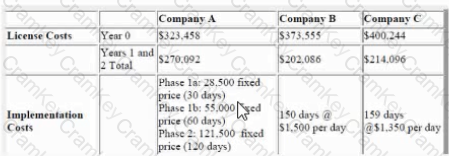| Exam Name: | Certified Business Analysis Professional | ||
| Exam Code: | CBAP Dumps | ||
| Vendor: | IIBA | Certification: | Certified Business Analysis Professional |
| Questions: | 497 Q&A's | Shared By: | agatha |
An insurance company wants to implement a business intelligence solution to consolidate data from various different internal system to provide a better understanding of their customer base.
A business analysis (BA) is engaged to put together a tender (bid) to be sent to various business intelligence providers and implementation partners. Among other information the business analysis requests the following:
* Licensing costs for year 0 based on needing 1 Central processing Unit (CPU) license
* Licensing costs for specific user types such as Report Creators Online Analytical Process (OLAO) user and Power users
* Predicted licensing costs for renewing in Years 1 and 2
* Full implementation costs
After reviewing the received vendor responses the project team shortlists the candidates to 3 and the BA structures the received information as follows:

The Insurance company has a maximum bucket of $310,000 for the entire to implementation and operation over the first three years. Which vendor or vendors meet that criterion?
A business analyst (BA) had identified redundancy in the process for the first contact resolution for customer issues: currently two separate a visions handle this task. A new solution identifies a single point of contact that will eliminate the redundancy. What can the BA do to highlight the required changes to the structure?
A business analyst (BA) is responsible for analyzing the effectiveness of a railway ticket booting system. The BA prepared a report based on observations of the booking clerk over two days (Monday and Wednesday). According to the information gathered, the booking clerk is underutilized and spends a lot of die time waiting for customers. What should the BA do next?
A large insurance company wants to buy a new claims processing system or upgrade one of its two existing system. Each year the claims department is given a $3.5 million budget to spend. Time is of the essence since there are tome regulatory charges that will be coming the following year that will require several features that currently neither one of the two claims System currently support.
There are eight stakeholders involved in this initiative. There are local to where the claim system is managed, while five are located across the country. The business analyst (BA) struggled to get all stakeholders to agree on the desired features but ultimately got agreement on ten identified key features for the new claims system. The BA was able to build a current state and future state process model which included all ten key features.
System a processes 75% of the company's claims. It is 5 years old and the claim processors love it because it is easy to use. However, it must go offline for two hours each day. The code is very module so it does have flexibility to be modified. To upgrade system A to have all ten features it would cost $5 million. System A would be at capacity if it were to process all of the company's claims.
System B process 25% of the company's claims. It is an older mainframe system, but rarely goes offline. It could easily handle double the number of claims that system A processes. However, it has a lot of legacy code and would cost $6 million to upgrade.
Both systems have some of the desired key features. But neither system has all ten. The cost to buy a new system would be $7 million.
Below is the estimated cost for each feature in priority order.

During elicitation the BA must understand the non-functional requirements. What nonfunctional requirement does System B support over System A?